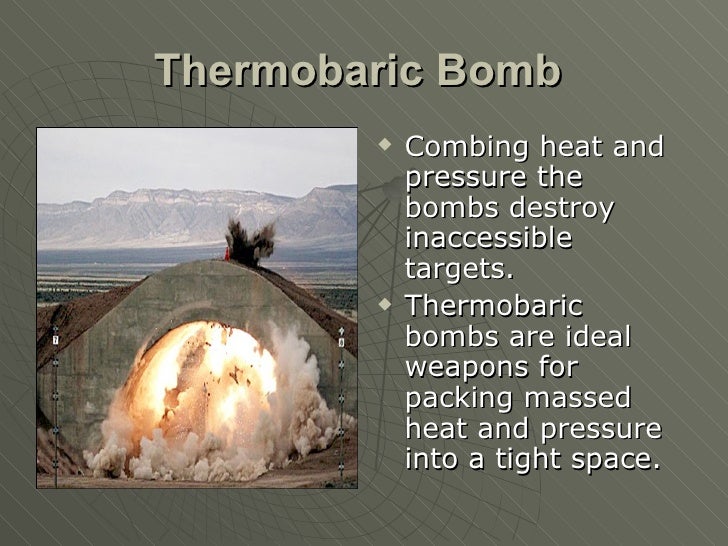Thermobaric Weapon! The great disruptive power!
A thermobaric weapon, aerosol bomb, or vacuum bomb, is a type of explosive that uses oxygen from the surrounding air to generate a high-temperature explosion. In practice, the blast wave typically produced by such a weapon is of a significantly longer duration than that produced by a conventional condensed explosive. The fuel-air explosive (FAE) is one of the best-known types of thermobaric weapons.
Most conventional explosives consist of a fuel-oxidizer premix (gunpowder, for example, contains 25% fuel and 75% oxidizer), whereas thermobaric weapons are almost 100% fuel, so thermobaric weapons are significantly more energetic than conventional condensed explosives of equal weight. Their reliance on atmospheric oxygen makes them unsuitable for use underwater, at high altitude, and in adverse weather. They are, however, considerably more destructive when used against field fortifications such as foxholes, tunnels, bunkers, and caves—partly due to the sustained blast wave and partly by consuming the oxygen inside.

A fuel-air explosive (FAE) device consists of a container of fuel and two separate explosive charges. After the munition is dropped or fired, the first explosive charge bursts open the container at a predetermined height and disperses the fuel (also possibly ionizing it, depending on whether a fused quartz dispersal charge container was employed) in a cloud that mixes with atmospheric oxygen (the size of the cloud varies with the size of the munition). The cloud of fuel flows around objects and into structures. The second charge then detonates the cloud, creating a massive blast wave. The blast wave destroys reinforced buildings and equipment and kills and injures people. The antipersonnel effect of the blast wave is more severe in foxholes and tunnels, and in enclosed spaces, such as bunkers and caves.

The [blast] kill mechanism against living targets is unique–and unpleasant. ... What kills is the pressure wave, and more importantly, the subsequent rarefaction [vacuum], which ruptures the lungs. ... If the fuel deflagrates but does not detonate, victims will be severely burned and will probably also inhale the burning fuel. Since the most common FAE fuels, ethylene oxide and propylene oxide, are highly toxic, undetonated FAE should prove as lethal to personnel caught within the cloud as with most chemical agents.


Comentários
Postar um comentário